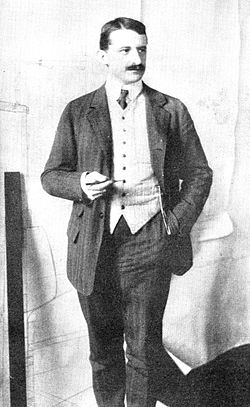This article includes a list of general references, but it lacks sufficient corresponding inline citations. (August 2009) |

Bruno Paul (19 January 1874 – 17 August 1968) was a German architect, illustrator, interior designer, and furniture designer.[1]
Trained as a painter in the royal academy just as the Munich Secession developed against academic art, he first came to prominence as a cartoonist and illustrator in the German fin de siècle magazine Jugend, and in the satirical Simplicissimus from 1897 through 1906, in the years where its criticism of Wilhelm II brought prosecutions from the government.
By 1907 Paul became one of the founding members of the Deutscher Werkbund, and had launched multiple careers in industrial design, interior design (notably, for Norddeutscher Lloyd's ocean liners), furniture design, and architecture. His work of the time reflects a historic stylistic transition from the curved shapes and floral imagery of Jugendstil to simpler forms, straighter lines, and an adaptation to machine production methods. By 1907 Paul had also been appointed Director of the state school for decorative arts in Munich, hired despite his earlier criticisms.
Through the next years, on parallel tracks, Paul pursued both educational reforms in applied art, and large commercial architectural commissions, for example Berlin's first high-rise, the Kathreiner-Haus of 1930. Paul's career effectively ended with the rise of National Socialism.
Among Paul's students and apprentices were Mies van der Rohe, Kem Weber, and Adolf Meyer.
- ^ "Bruno Paul". British Museum. Retrieved 5 July 2021.